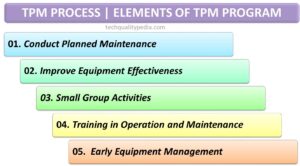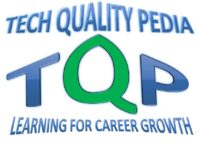Table of Contents
TPM PROCESS | TPM DEFINITION
TPM Process aims to continuously improve the effectiveness of the production equipment or manufacturing processes through the people’s involvement within the organization.
TPM Definition: “Company-focused, Self-directed, cross-function workgroup, working together to improve the overall effectiveness of the equipment and processes within their work area.”
TOTAL PRODUCTIVE MAINTENANCE OBJECTIVE
TPM Process objective or aim is to improve the company by working toward the “Concept of Zero”
- Zero Machine Trouble
- Zero Breakdowns
- Zero Accidents
- Zero Waste
- Zero Quality Defects
TOTAL PRODUCTIVE MAINTENANCE SYSTEM
The Total Productive Maintenance System or TPM Program is comprised of five major elements:
1. Conduct Planned Maintenance
2. Improve Equipment Effectiveness
3. Small Group Activities
4. Training in Operation and Maintenance
5. Early Equipment Management

1. CONDUCT PLANNED MAINTENANCE
Maintenance is performed by skilled persons/trades, usually as an emergency repair, sometimes preventive or predictive maintenance is also performed.
• The skilled persons/trades usually coach the operators to expand their understanding of the equipment.
2. IMPROVE EQUIPMENT EFFECTIVENESS
-Improve equipment effectiveness by eliminating waste and reducing operating costs through total employee participation and involvement.
–Measurement of equipment effectiveness is a product of three factors-
•Availability is how often the equipment runs when you want to run.
•Performance efficiency is how close the equipment is actually running to its design limit cycle time).
•Quality Rate is basically first-run quality. It is the number of good parts minus defective parts produced.
3. SMALL GROUP ACTIVITIES
The Small Groups maintain the improved levels through visual controls and increased process awareness.
Some activities are:
• Measuring and Eliminating Forced Deterioration.
• Restoring Equipment to Its Ideal Level of Operation.
• Elimination of Problems that affect Productivity.
4. TRAINING IN OPERATION AND MAINTENANCE
Training the existing workforce is to make “Each employee the best there is.”
Small Group training includes such topics as:
-Seven Steps for Small Group Activities-SGA
-Visual Inspection Techniques
-Data collection
-An understanding of:
• Lubrication
• Hydraulics / Pneumatics
• Fasteners
• Electricals /Electronics
In addition, training for skilled trades also includes such topics as:
• Preventive Maintenance Techniques
• Vibration Analysis
• Ferrography
• Reliability and Maintainability (R&M)
• Ultrasound
• Infrared analysis
5. EARLY EQUIPMENT MANAGEMENT
•Early Equipment Management is a process that minimizes the life cycle cost of new equipment.
•Reliability and Maintainability(R&M) of equipment and processes are heavily dependent on the initial design.
•R&M requires the capture of data in order to calculate life cycle costs and MTBF and to provide a feedback mechanism that will allow suppliers to improve the R&M of new equipment.
TPM PROCESS BENEFITS
The benefits of the TPM process or program are:
- Higher safety at the workplace
- Job security for all employees
- Improved Quality
- Increased Productivity
- Improved Competency and Skills
- Improved Uptime
- Increased Capacity
- Improved Profit
- Reduction in cost of poor quality-COPQ
